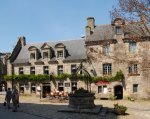BEYOND LIMOGES
Beyond Limoges, the landscapes of Limousin amply reward the visitor who takes the time and trouble to explore them, off the beaten track. Great rolling plains given to agriculture and woodland, and criss-crossed by a network of sinuous back roads ignored by all but a few hardy cyclists are simple splendid, dotted as they are by countless towns, villages and hamlets of varying sizes that still embrace an air of mysticism, where legend and tradition live on.
Perhaps not instantly obvious as you drive by is the fact that many roads are lined by chestnut trees. This is the land of chestnuts, and they are very much a local passion, used in liqueurs and numerous forms of cooking including a local speciality boudin de châtaigne. Many towns and villages have chestnut festival, and you can be fairly certain as you drive along that the sudden bang on the roof of the car is a falling chestnut.
To the east of Limoges, along the Vienne, lies the small-town-large village of Saint-Léonard-de-Noblat, perched on a hill above the river. This pleasing community is named after Saint Leonard of Noblac, who was responsible for the liberation of many prisoners in 11th century France. The town is a delight to tour. There are numerous medieval and half-timbered houses with projecting eaves adorning its winding streets, and the Romanesque church, which has fine flying buttresses, is listed by UNESCO as part of the World Heritage Sites of the Routes of Santiago de Compostella in France. Saint-Léonard-de-Noblat is the hometown of famous chemist and physicist, Joseph Louis Gay-Lussac, and a little museum is devoted to his discoveries. Another famous inhabitant is Raymond Poulidor, the legendary bike racer considered to be the most popular cyclist France ever had, even though he never won the Tour de France. The former paper mill, the 15th-century Moulin du Got, a couple of miles to the north-west has been tastefully restored and is a now a museum with original machinery still in working order.
Just to the north of Saint-Léonard, the tiny village of Lajoumard, is believed to be one of the oldest communities in Limousin, while further to the east, lying at the northern end of the plateau de Millevaches, by a splendid wooded drive between the Vienne and the Maulde, by way of Bujaleuf, lies the busy town of Eymoutiers, a former tanning and leather industry centre, and historically developed around its much-altered collegiate church. Like Saint-Léonard, the town is small-scale, but has an endearing charm, and serves as a useful base for exploration, away from the city lights of Limoges.
A fine drive leads south for Eymoutiers, through a landscape of undulating woodland and farmland populated by fallow deer and Limousin cattle that regard you with affected disinterest as you drive by. The way to Chamberet is especially agreeable, and perfectly designed for leisurely driving, although this circuit dips briefly into Corrèze before returning to Haute Vienne and heading for Mt Gargan and St Germain-les-Belles to Coussac-Bonneval.
The once-moated chateau at Coussac, while pricey to enter, is a splendid edifice set in neatly tended grounds, and has been in Bonneval family possession for over a thousand years, although the multi-towered castle dates mainly from the 14th century. The rooms are sumptuous and extravagantly decorated, among which are some fine and renowned Aubusson tapestries.
Close by, and not content with its contribution to the wealth of Limousin generally, Saint Yrieix la Perche (pronounced Saint Irieh) also has a history of gold mining that goes back to Roman times. A long period of obscurity ended in 1866 when it was discovered that the foundations of the town were in fact disused gold mines. Mining was resumed, and continued until 2001, by which time the mine at nearby Le Bourneix was the last working gold mine in Europe.
North from Coussac-Bonneval a splendid winding road leads through the forest of Fayat to the dilapidated castle at Chateau Chervix, and on across undulating farmland through St Priest-Ligoure and St Jean-Ligoure back towards Limoges. The pretty village of Solignac on the river Briance, a few miles before you reach Limoges, is medieval, and its huge granite church an indication that this was a pilgrims’ stopover on the way to Compostella. The sometime abbey-church was built during the 12th century in the so-called Limousin-Romanesque style, and its choir stalls have fascinating misericords. Otherwise, Solignac is an unaffected but busy little village with a positive-minded community.
Further west, much of the countryside is associated with the campaigns of Richard the Lionheart, son of Eleanor of Aquitaine and as such equally French and English. You can follow a circuitous Route du Richard Coeur de Lion, and this will lead you by a charming roundabout route to the small town of Chalus, where, outside the now ruined chateau, the king, while endeavouring to suppress a rebellion against English rule, was mortally wounded by an archer. Once the castle had been captured, the king, breathing his last, ordered all the rebels hanged, save for the archer, whom he pardoned. It was a short-lived reprieve, for no sooner had the king died than the captain of the English army had the archer flayed alive.
To the north-west of Limoges, the town of Oradour-sur-Glane is spread across a broad hillside; it looks down on the remnants of its old town, destroyed by Germans on 10 June 1944, when 642 inhabitants were massacred. Only six escaped. Whether this sort of pseudo-macabre ‘preservation for posterity’ is bona fide tourism only each of us can say individually as we face the conflict and sadness of what the scene represents. It is, admittedly, very moving. But the answer to the question ‘Why do we find it moving?’ is a subjective issue. As with the battlefields of the Somme, only by coming face to face with the past and making a study of it do we begin to have a chance to understand. In that regard, Oradour-sur-Glane is a valid tourist destination, but you may need a stiff drink in the new town square afterwards.
Of the seven ‘Most Beautiful Villages in France’ in Limousin, six are in Corrèze, and only one in Haute Vienne. The charming little village of Mortemart on the edge of the Monts de Blond was once the home of the Mortemart family, whose moated chateau now lies in ruins. This tiny hamlet is exquisite, appreciated all the more by enjoying a leisurely drink close by the 17th-century market hall. There are two monasteries here, one Carmelite the other Augustine, but it is the leaning onion-shaped bell tower of its church that catches the eye. How long it has been leaning, and how long it will continue to lean, is pure speculation. Of course, it helps in your appreciation of this modest-sized community if your arrival is preceded by a measure of freelance wandering, preferably lost, through the delightful wooded lanes and many fishing lakes of the Monts de Blond. Menhirs and so-called sacrificial stones dot the landscape and tell of a much earlier occupation, that by prehistoric man. And seeking these out, to enjoy the generally short walks to their locations, is an agreeable preparation for lunch.
Recent Articles
-
French Food and Drink - No BS Guide for lovers of Food, Wine, Liqueurs
Aug 28, 19 03:18 AM
Our guide to French food and drink for those who love traditional French food along with our no BS guide to understanding French wine and liqueurs
-
Things To Do In Carcassonne The Ultimate Tourist Guide
Aug 24, 19 06:26 PM
The ultimate tourist guide to things to do in Carcassonne when you visit this wonderful town in Aude France. Discover the places to go and see in Carcassone.
-
Lyon Old Town Guide to Vieux Lyon
Aug 18, 19 07:48 AM
Your complete guide to Lyon old town otherwise known as the Vieux Lyon. Don't miss this amazing part of the city if you're visiting Lyon in France.
-
18 French Villages You Must Visit Most Beautiful Villages in France
Aug 17, 19 06:31 AM
Our guide to the 18 most beautiful French villages you simply must visit. Loads of info, photos and facts in our ultimate villages in France tourist guide
-
What a Pissoir - The True Story of France's Unique Urinals
Aug 13, 19 03:47 PM
Is there anything more French than a pissoir? Sadly on the decline nevertheless the pissor is an endring image of the country. This is their story





